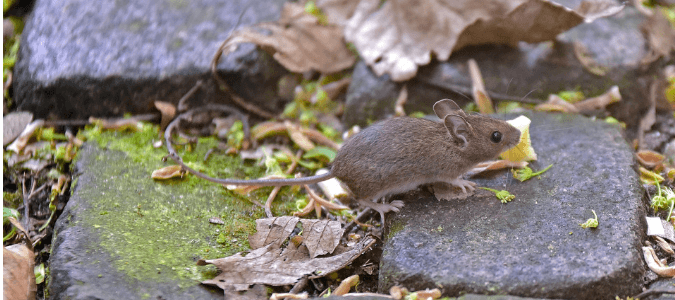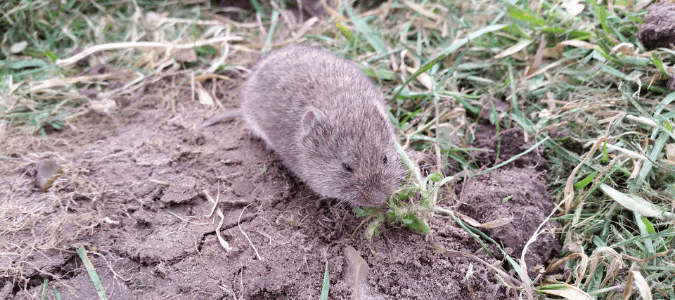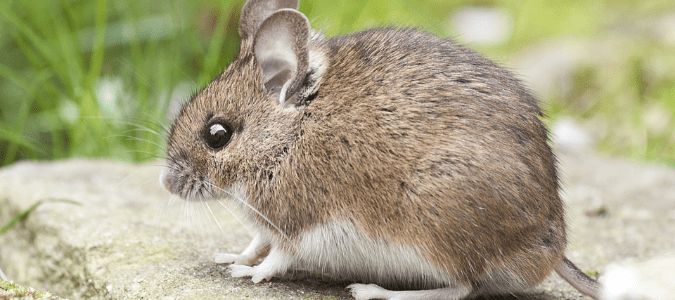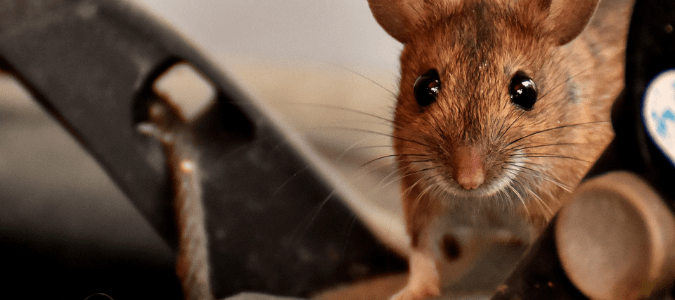A mouse is not just a mouse. There are many different kinds of mice throughout the world. In fact, mice are a part of the rodent group. This includes thousands of different types of small and tiny mammals that use their front teeth to gnaw on things. Each kind of rodent has some things in common, but they also have several unique characteristics.
Knowing what kind of rodents you have can help you figure out why they entered your home and how to make them leave. Otherwise, you might waste precious time and money trying pest control treatments that will not work. That is why it is best to contact a qualified pest control professional to handle rodent invaders. These experts have the training and experience to take care of everything effectively and efficiently for you.
House Mice
House mice are one of the most common types of rodents found in and around homes. Pictured above, these mice are tiny, light brown or gray rodents with small, black eyes. Including their tail, these critters are just about five to seven inches long, and they weigh around one half of an ounce. Their tails are mostly hairless and are typically around three to four inches long. Compared to the house mouse’s small body, their ears are relatively large.
These rodents can come out during the day, but they are more likely to be active at night. They are more likely to enter manmade structures like houses around autumn or when the temperatures start to drop outside. House mice build nests in dark, sheltered areas. If they get in a house, these pests usually live in places like attics and wall voids.
They can make their nests out of a variety of fibrous materials they might find around your house, such as shredded paper, insulation or fabric. House mice can seriously damage your home when they are gathering these materials and gnaw on wiring and structural parts of the house. Some common signs that you might have house mice include droppings, gnaw marks, tracks, and a musky odor.
House mice prefer to eat seeds and cereal grains. However, they are adaptable and will nibble on many different kinds of foods, including pet food, livestock feed and food for humans. If house mice get into your food supply, it can be dangerous for you and your family. The main threat these critters pose to humans is that they can transmit salmonella. House mice carry this disease in their droppings and spread it by contaminating food. They might walk through feces and then contaminate food when they get into a package of human food or walk across surfaces like countertops.
Voles
People sometimes use the name field mice or meadow mice to refer to voles. However, these creatures are actually a different kind of animal. Voles are small mammals that are sometimes confused with other rodents like house mice because of the way they look. But voles actually behave more like gophers. They mostly live in places like wildlands, fields and gardens. These critters are not good climbers, and they do not typically invade houses.
Voles have stocky, compact bodies. Including their tail, voles are around five to eight inches long. They have dense fur that is typically grayish brown or blackish brown. They also have short legs, small eyes and partially hidden ears.
These rodents spend most of their time in underground burrows. However, you can see them scurrying around gardens and fields when they come out to look for food and materials for nests. Voles build their nests underground using stems, grass and leaves. They mostly eat grass and other plants or parts of plants like tubers, bulbs, roots and bark.
Voles typically do not bite people. They are usually a bigger threat to your garden than anything else. Voles can quickly destroy vegetables, landscaping and trees. They often feed on common garden plants like carrots, spinach, tomatoes, beets and sweet potatoes. Voles can also damage grass and other types of plants like lilies. Additionally, they often gnaw on the roots and bark of trees and can ruin fruit trees, such as avocado, olive and almond trees.
Common signs that you might have a vole infestation include gnawing on the base of fruit trees or nibbling on plants or your lawn getting dug up at night. Voles’ tooth marks are smaller than many other types of garden pests. If a vole has attacked your plant, the tooth marks will be just about an eighth of an inch wide and less than half an inch long. You might also have voles if you see runways between burrows, as well as grass clippings and vole droppings close to burrow openings.
Vole droppings are less than a quarter-inch long, and they usually have a greenish color because of their plant-based diet. The openings for vole burrows are about one and a half to two inches wide. For protection, voles typically build these burrows in sheltered areas. You are most likely to find burrows under heavy mulch, overgrown weeds or another type of dense vegetation.
Deer Mice
Deer mice are one of the most abundant kinds of mice in the United States. These tiny rodents are just about two and a half to four inches long. They have gray fur on top of their bodies and white bellies, legs and feet. Their tails are furry, and like their bodies, their tails also have a dark coloring on top and a lighter color on the underside.
This type of mouse prefers to eat seeds, but they will also feed on fungi, fruit and other vegetation. A common sign that you have deer mice on your property is if you find a collection of nuts and seeds. Deer mice usually live in fields, forests and agricultural areas. It is not common to find these rodents in most residential areas. However, if you live close to places like a park, grassland or forest, then it is possible that they might invade your home. These critters are great runners and jumpers, so they can easily get into structures like houses.
When deer mice are outside, they typically build nests inside tree hollows or under logs and rocks. They make their nests from leaves, stems, roots and twigs. They sometimes also line their nests with feathers, fur or shredded cloth. Sometimes, instead of building a new nest, deer mice choose to live in nests abandoned by other animals like birds or squirrels.
If deer mice get inside your home, they might build a nest there and can cause a lot of damage. They might tear up clothes, mattresses and upholstered furniture while they gather materials to build a nest.
Additionally, a deer mouse infestation can also be a health risk. These pests carry Sin Nombre virus, which can cause the potentially fatal hantavirus pulmonary syndrome. This is a severe respiratory disease that deer mice carry in their urine, saliva and poop. A common way that people get infected is if they mistakenly inhale dust contaminated by feces while they are trying to clean up a deer mouse infestation.
Can Mice Jump?
Mice have several impressive skills. For one, they can jump from the floor to surfaces 12 inches above them. They can also run along narrow ropes and wires like the cables that run between utility poles and your home. Additionally, mice can climb up rough vertical surfaces and squeeze through holes as small as a quarter-inch wide.
All of these skills make it easy for mice to break into homes. If you think you might have a rodent problem, it is wise to contact a pest control professional as soon as possible. They can control the mice quickly before the problem gets even worse. Once mice get inside, they are able to reproduce in record time. These pests can get pregnant when they are just six to ten weeks old and can give birth to dozens of babies each year.
How to Keep Mice Out of Your House
One of the best ways to keep mice out of your home is to make it less attractive to rodents. This involves sealing up any gap or hole on the outside of your house where a mouse might be able to get in. Use rodent-proof materials to close off openings in places like cracks around windows, chimneys, doors, vents and crawl spaces. Additionally, trim any tree branches that are close to the home to prevent mice from getting into your attic.
It is also important to remove their access to food. Many kinds of mice will eat whatever they can find. They might break into food packages in your pantry or eat your pet’s leftovers from their bowl. That is why it is essential to store food in rodent-proof containers and quickly remove food that your pet does not eat.
The easiest way to keep mice away is to sign up for ongoing rodent control services. With this program, a professional can seal off even the smallest cracks where a mouse could slip in. These experts can take care of everything for you, so you do not have to worry.
ABC Can Control Any Type of Mouse on Your Property
Dealing with a mouse problem can be time-consuming and frustrating. Instead of dealing with this on your own, contact ABC Home & Commercial Services. Our licensed professionals will create a customized rodent control plan, so you can feel comfortable at home again.





